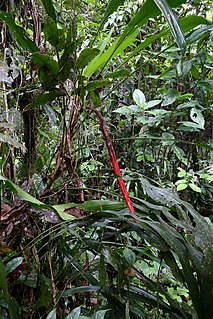
The Bromeliaceae is a family of monocot flowering plants of 75 genera and around 3590 known species native mainly to the tropical Americas, with several species found in the American subtropics and one in tropical west Africa, Pitcairnia feliciana.

Pitcairnia is a genus of plants in the family Bromeliaceae, subfamily Pitcairnioideae. It was named for William Pitcairn, Scottish physician and gardener (1711–1791). The genus Pitcairnia ranks as the second most prolific of the bromeliad family. They are most abundant in Colombia, Peru and Brazil, but can also be found in areas from Cuba and Mexico south to Argentina. One species, Pitcairnia feliciana, is found in tropical West Africa and is the only member of the family Bromeliaceae not native to the Americas.

Pitcairnia subg. Pepinia is a subgenus of plants in the family Bromeliaceae. It has at times been treated as the separate genus Pepinia, but is now included again in the genus Pitcairnia. The name is for Pierre Denis Pépin, French member of the Imperial and Central Society of Agriculture (c.1802-1876).
Pitcairnia carnososepala, synonym Pepinia carnososepala, is a species of flowering plant in the family Bromeliaceae, endemic to Ecuador. It was first described by in 1987. Its natural habitats are subtropical or tropical moist lowland forests and subtropical or tropical moist montane forests. It is threatened by habitat loss.
Pitcairnia harrylutheri is a species of flowering plant in the family Bromeliaceae, endemic to Ecuador. It was first described by Harry Edward Luther in 1991 as Pepinia fulgens. When transferred to the genus Pitcairnia in 1999, the epithet had to be changed, as the name Pitcairnia fulgens had already been used. Pitcairnia harrylutheri is a replacement name. The natural habitats of the species are subtropical or tropical moist lowland forests and subtropical or tropical moist montane forests. It is threatened by habitat loss.
Pitcairnia harlingii is a species of flowering plant in the family Bromeliaceae, endemic to Ecuador. It was first described by Lyman Bradford Smith in 1961. Its natural habitats are subtropical or tropical moist lowland forests and subtropical or tropical moist montane forests. It is threatened by habitat loss.
Pitcairnia hooveri is a species of flowering plant in the family Bromeliaceae. It was first described by Harry Edward Luther in 1991 as Pepinia hooveri. It is endemic to Ecuador, where it grows in coastal and mountain forest habitat. There are four known subpopulations, none of which is in a protected area.
Pitcairnia elvirae, synonym Pepinia verrucosa, is a species of flowering plant in the family Bromeliaceae, endemic to Ecuador. It was first described in 1999. Its natural habitats are subtropical or tropical moist lowland forests and subtropical or tropical moist montane forests. It is threatened by habitat loss.
Pitcairnia devansayana is a species of flowering plant in the family Bromeliaceae. It is endemic to Ecuador. Its natural habitat is subtropical or tropical moist montane forests. It is threatened by habitat loss.
Pitcairnia reflexiflora is a species of flowering plant in the family Bromeliaceae. It is endemic to Ecuador. Its natural habitat is subtropical or tropical moist montane forests. It is threatened by habitat loss.

Pitcairnia bulbosa, synonym Pepinia bulbosa, is a species of flowering plant in the family Bromeliaceae, native to Colombia and Venezuela. It was first described by Lyman Bradford Smith in 1955. In Colombia, it is found in dry rich soil in crevices of granite rock.
Pitcairnia leopoldii is a species of flowering plant in the family Bromeliaceae, endemic to Venezuela. It was first described in 1994 as Pepinia leopoldii.
Pitcairnia aphelandriflora is a species of flowering plant in the family Bromeliaceae, native to Panama, Ecuador and Peru. It was first described by Charles Antoine Lemaire in 1869.
Pitcairnia cuatrecasasiana, synonym Pepinia cuatrecasasiana, is a species of flowering plant in the family Bromeliaceae, native to Ecuador and Colombia. It was first described by Lyman Bradford Smith in 1942. The specific epithet is also spelt cuatrecasana.

Pitcairnia arcuata is a flowering plant in the Bromeliaceae family. It is native to Costa Rica, Panama, Colombia, Peru, and Ecuador.
Pitcairnia macranthera is a species of flowering plant in Bromeliaceae family. It is native to Ecuador.
Pitcairnia nigra is a species of flowering plant in the Bromeliaceae family. It is native to Ecuador.

Pitcairnia caricifolia, synonym Pepinia caricifolia, is a species in the genus Pepinia. This species is native to tropical South America.
Pitcairnia pruinosa, synonym Pepinia pruinosa, is a species of flowering plant in the family Bromeliaceae, native to Colombia and Venezuela. It was first described by Carl Sigismund Kunth in 1816.
Pitcairnia turbinella, synonym Pepinia turbinella, is a species of flowering plant in the family Bromeliaceae, native to Colombia and Venezuela. It was first described by Lyman Bradford Smith in 1942.





